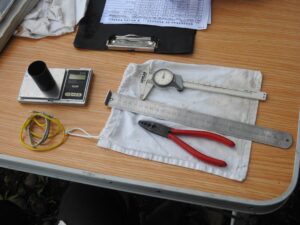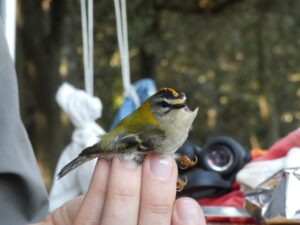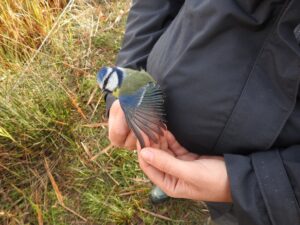Ringing, an indispensable tool for the preservation of species
A quick reminder!

The perfect ringer’s kit ©Laura Granicz
In an article published on our website in 2019 (read here), we explained the “how” of ringing (‘banding’ in the US), an essential activity in our conservation programme, since the creation of A Rocha in 2000!
Let us simply remind you that all study programmes requiring the capture of birds for ringing purposes are regulated by law, and can only be implemented after validation by the CRBPO-MNHN. Only qualified ringers who are up to date with their annual ringing authorisation are authorised to carry out this activity.
From rings to protocols

Using mist nets to catch birds for ringing at the Ilon Marsh ©Laura Granicz
If at the beginning, ringing was used to understand the phenomenon of migrations, today it is used for species conservation purposes. Indeed, the large quantities of data obtained make it possible to better know and understand the functioning of ecosystems and the species studied, and thus to make the conservation measures implemented more relevant.
It is thus possible to correlate the decline of bird populations with phenomena linked to human activities (degradation of their habitats, climate change, disappearance of insects, etc.).
Protocols that are being refined
To make the data obtained as informative as possible, there are a number of ringing protocols that have evolved over time (STOC, ROUTE, STAY, PHENO, etc.). Depending on whether we are studying breeding success, variations in migration routes and periods, or migratory stopover sites, the capture effort will vary seasonally and/or in intensity.
What species is A Rocha France targeting?

Firecrest (Regulus ignicapilla) ©Laura Granicz
In 2020, we implemented two distinct ringing protocols on our preferred study site, the Ilon marsh:
The VOIE protocol: this aims to document variations in migration routes between individuals, in space and time, for a few species with a high ringing pressure in Europe, and generating a large number of allo-controls (capture of individuals having been ringed on another site). At Ilon it is mainly a question of targeting the barn swallows which gather at the end of the summer and form one of the largest and most regular dormitories in Europe, a dormitory which we have been monitoring since 2006!
The PHENO protocol: its aim is to document the variations in migratory phenology of passerines between individuals, in space and in time. We carry out this protocol throughout the post-nuptial migration season, i.e. from the end of August to the end of November. We began it on our study site from 2019.
Time to take stock

Blue tit (Cyanistes caeruleus) ©Laura Granicz
Last year, we carried out 26 ringing sessions on this site (14 for the PHENO protocol, 12 for the VOIE protocol). In total, we captured 5211 birds of 41 species.
You can find the details of our results in our special report: Read it here (pdf format)
Some highlights in 2020
The most striking point is undoubtedly the abundance of kingfishers Alcedo atthis, with nearly 30 different individuals captured on the site, as many as in 2019. Also of note was the ringing of a Least Bittern (Ixobrychus exilis), representing the third capture on the site, as well as the first Yellow-browed Warbler (Phylloscopus inornatus) and the first Savi’s warbler (Locustella luscinoides) on the site.
The monitoring period for the PHENO protocol has just ended at the Ilon marsh for the 2021 season. While waiting for the 2021 report, we can already tell you that once again the birds have given us some nice surprises!
